

New Self-Propelled Diesel Cars Go Into Operation
The advent of the Budd car to the Canadian railway scene represents a new and important step forward.
The proven success of the modern self-propelled car, both in America and abroad, made the acquisition of four
of the cars, by the C.P.R. a logical move. The Company has been well to the fore in pioneering various
improvements in the transportation picture in keeping with the principles upon which it was founded and which
have guided its destiny to the globe-encircling travel system which we now know.
Every comfort device known to railway equipment designers has been incorporated in the RDC car. It is of all-stainless-steel construction and was introduced to the railroad world in September, 1949. The success of the car was immediate and within a year, 45 RDC cars had been purchased by rail lines, not only in the United States, but in Australia and Cuba as well.
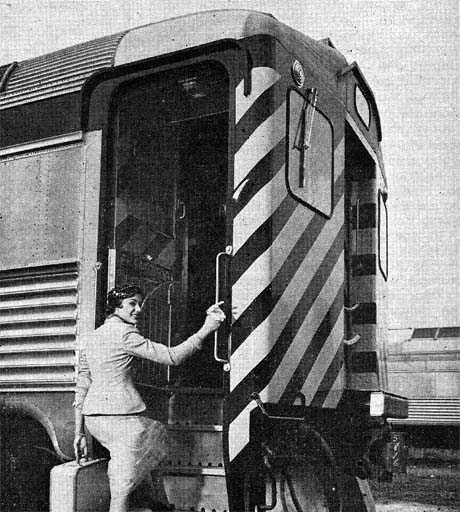
Since that time, Budd RDC cars have been purchased by other railways, some going as far afield as Saudi Arabia, for use on that country's Government railways. Now, the Budd car has been introduced in Canada, as part of the Company's recently inaugurated policy of improvement in passenger travel.
What is the Budd car? Well, briefly, it is a self-propelled rail car presently manufactured in four types, depending upon the proportion of passenger, mail, baggage, and express traffic in the services to which the car is introduced.
RDC-1, the first type introduced, and most widely used model at the present time, is designed to carry passengers exclusively. It has seating capacity for 89 persons. The car body is divided into two sections which can be utilized as smoking and non-smoking compartments if desired. It can be equipped with any type of seating from low-backed commuter seats, to deep reclining seats for long distance travel. RDC-2 is a similar unit, but possesses seating for 71 passengers only, in the place of the additional seating found in the RDC-1, RDC-2 has a 17-foot baggage section.
A postal compartment in addition to the baggage section is found in the RDC-3 model, Which seats only 49
passengers. All of the three foregoing models are 85 feet in length. The last unit, more recently introduced is
the RDC-4, which has space for baggage or express and mail only, with no facilities for passengers. It is
designed to be used in multiple with the RDC-1 model, and is only 73 feet long.
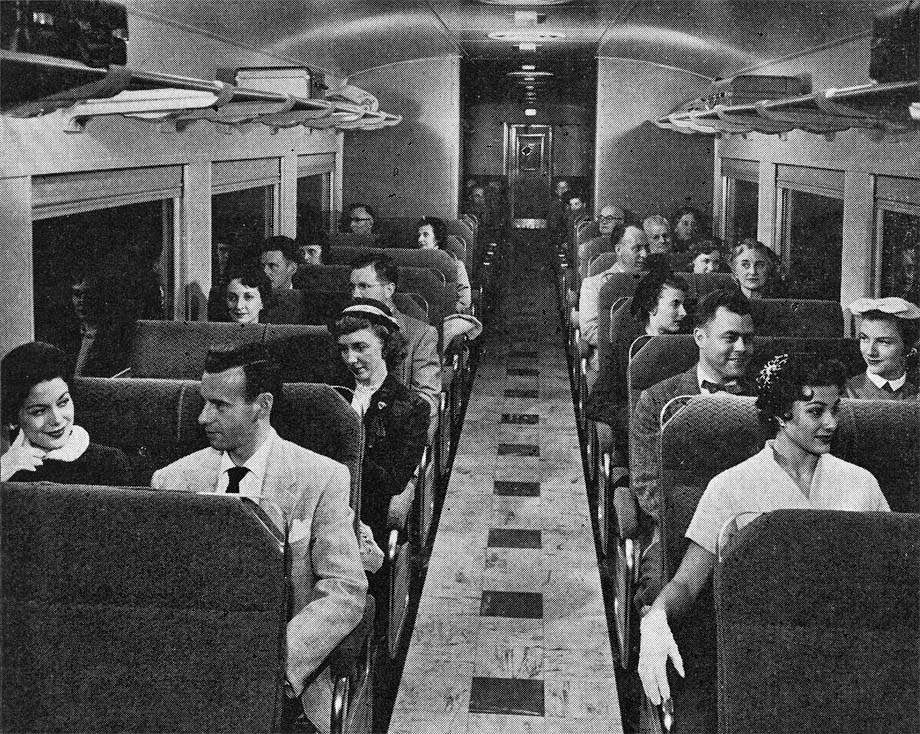
The RDC cars are propelled by the diesel mechanical principle, that is, the diesel engines are connected
to the driving axles by a mechanical torque converter transmission. Each car is equipped with two 275-horsepower
General Motors diesel engines mounted under the floor, so that no revenue space is taken up by the power units.
The cars can be operated in multiple, that is to say, a number of them can be coupled together and operated
from a single control with no loss in speed, acceleration, or power, since each car propels itself. The RDC
car's high power-weight ratio of 8.68 horsepower per ton is thus preserved, no matter how many units are placed
together to form a train. The acceleration of the RDC car is remarkable. From a standing start, it will do five
miles in five minutes. It accelerates to 57 miles per hour in one mile, or to 44 miles per hour in one minute.
The recommended cruising speed of the RDC is 70 miles per hour, but it will do 83 m.p.h. on level tangent
track, with a full load.
Like all modern railway passenger equipment the RDC cars are air-conditioned, and in winter they are heated with what would otherwise be waste heat generated by the diesel engines. There are individual lights over each seat, and wide picture windows, which make the car comparable to the latest in conventional passenger car equipment, as far as the traveller is concerned.
In November, the cars are destined to go into Company service in two important areas, out of Toronto and out of Montreal. Two RDC-1's, the all-passenger type, will be used in a speeded up service between Toronto, London, and Windsor, Ontario, while another RDC-1 will be operated between Montreal and Mont Laurier in the Laurentian Mountains, in the same manner as test car 2960 was operated in the winter of 1952-1953. Finally, an RDC-3 (that's the mail-baggage-passenger model) will be put into service between North Bay and Angliers, via Mattawa, in the Temiskaming area. For these three important services, the cars have been christened "Dayliners", a name which will no doubt become a byword among the Company's patrons wherever the RDC cars are introduced.
As the new cars are placed in service, it is interesting to look in retrospect at the varied forms taken by self-propelled rail cars through the years.
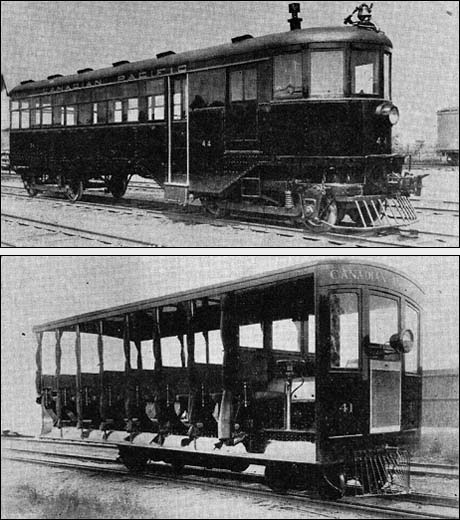
BOTTOM - Narrow gauge gasoline passenger car No. 41 is shown as it was outshopped from Angus in 1912.
While the self-propelled cars have been few in number, they represent a great diversity of types and include what has been determined by historians to be Canada's first rail car propelled by an internal combustion engine. This rather unusual looking piece of rolling stock was No. 520, and it was built by the Company in its shops in Montreal in the year 1902, just fifty-one years ago. The general design was patterned after its contemporary, the open-bench trolley car, though it was smaller and seated but fourteen passengers. The gasoline engine was in its infancy and when No. 520 was built, its size was kept within the limits imposed by the primitive engine and the outcome was a single-truck vehicle, with roof and ends, but open sides equipped with canvas curtains for inclement weather. This car was used to carry passengers between Place Viger station and Ste. Therese in the Montreal area, until it was scrapped in 1908.
It is not clear why the car suffered such an untimely demise, but there is little doubt but that the objection lay in the size and design of the car, rather than in its means of propulsion. Another factor which may have played a part in relegating No. 520 to the scrap pile, was the introduction of No. 88, a self-propelled steam car which seated 56 passengers and was 72 feet long, compared to No. 520's 13-foot length. Steam cars were quite common at this time, and they have been used to a certain extent in Canada, though No. 88 was the only example to be found on the Company's lines. The principle was quite old at the time No. 88 was introduced in 1906 and at least one steam car had been in use on the lines of the Great Western Railway in Ontario in the 1870's.
Following the scrapping of No. 520 in 1908, the Company was not without gasoline passenger cars for long. In 1912, a narrow-gauge tramway line was built from the station at Lake Louise, to the world-famous Chateau Lake Louise, for the transport of guests at the hotel, and their baggage. A road existed between the station and hotel, but road and automobile propulsion at that time were deemed unsatisfactory by the Company management, hence the building of the tramway line.
The rolling stock of the Lake Louise Tramway, built by the C.P.R. in its own shops, consisted of three
narrow gauge, open-sided gasoline passenger cars numbered 40 to 42 and one gasoline freight motor, No. 49.
Passengers disembarking at the Lake Louise station platform were met by one or more of these vehicles and after
a journey of several miles, climbing steadily to overcome the thousand-foot difference in elevation between the
station and the hotel, they were deposited safely on the hotel grounds, with the awe-inspiring beauties of Lake
Louise and the Victoria Glacier laid out before them.
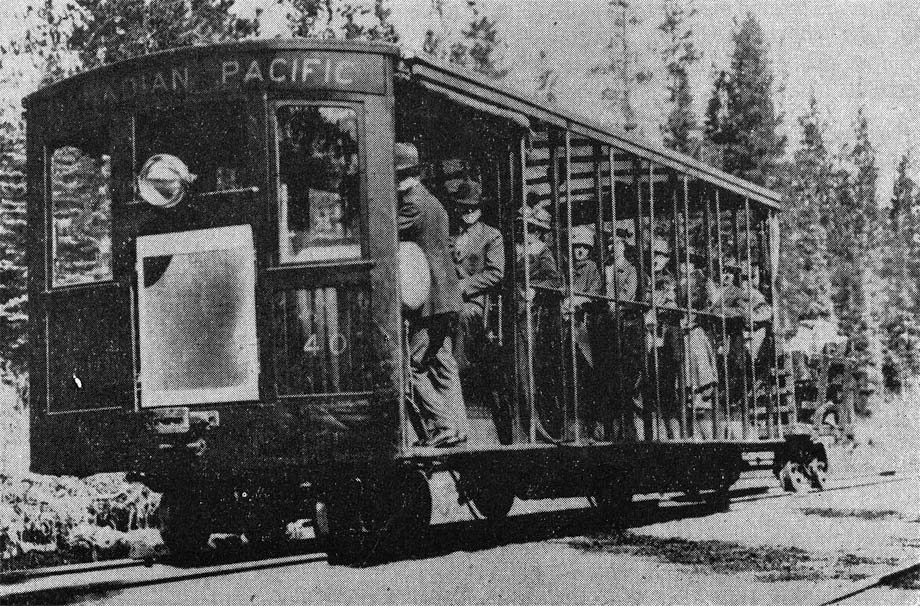
In 1925, two closed-sided cars were added to the Lake Louise Tramway, numbered 50 and 51.
One of the most popular types of self-propelled rail car in the United States was that built by the McKeen Company, and the bullet-nosed McKeen car earned a popularity which was not rivalled by any single competing design, until the advent of the Budd car. At least one of these vehicles was used in Canada, though not by the Company.
Competition introduced by the motor age resulted in several rail car acquisitions in the 1920's. The first was car 43, a 29-foot long gasoline car, which seated 30 passengers and was built by the Ledoux-Jennings Manufacturing Company in 1922. Actually, No. 43 was one of two cars being built by the manufacturer for the subsidiary Quebec Central Railway, but was diverted to the parent C.P.R.
Undoubtedly the fact that the Ledoux-Jennings establishment was located in Montreal within a stone's throw of Windsor Station, and that the construction of the cars was under consequent close surveillance by the motive power officials, played some part in its adoption by the CPR. No. 43 was characterized by its engine which protruded from the front of the car, and by the use of side-rods on the truck wheels to obtain maximum traction.
Two years later, in 1924, car 44 was out-shopped by the Ottawa Car Manufacturing Company, and its resemblance to the American McKeen car is striking. It had a seating capacity of 40 and was also gasoline driven. Cars 43 and 44 were scrapped in 1939, after having served for some years on the Montreal LaSalle Loop line.
In 1925, Car 45 was built for the Company by Canadian Car & Foundry and it represented a step forward in a different direction, because it made use of electric motors propelled by storage batteries housed underneath the car floor, instead of direct drive gasoline engines used in the predecessor cars.
Car 44 may be said to have been one of the first streamlined units owned by the Company, being equipped with a bullet-shaped front end. This suggestion of speed was probably in the nature of wishful thinking on the part of the designer, rather than a testimony of fact.
Smoother starting and greater flexibility of control was afforded by the use of electric motors. While no further battery cars were built for the C.P.R., gas and diesel-electric propulsion, wherein the internal combustion engine drives a generator producing current for electric motors, was in widespread use in America, until the advent of torque-converter transmission as exemplified by the Budd RDC car.
Finally, in 1930, the Company initiated the purchase of the first of the widely used 9003 series of 72-foot gas-electric combination baggage and passenger cars. In that year, two units, Nos. 9003 and 9004 were built by the St. Louis Car Company. About the same time, storage battery car 45 was converted into a trailer numbered 9002, to be used with the 9003 series motors.
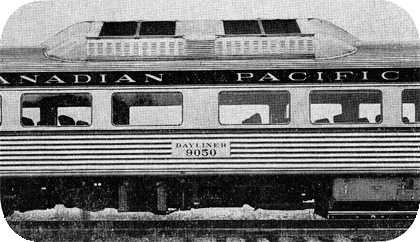
Four units, almost identical with the 9003 and 9004 were bought in 1931-1932 from the Ottawa Car Mfg. Co. and were given numbers from 9005 to 9008 inclusive. For a time No. 9006 was equipped with a diesel, instead of a gasoline engine. These cars weigh about 75 tons each and seat 50 passengers in addition to the baggage and express compartment, with the exception of Nos. 9007 and 9008, with space for 25 passengers only. In 1932, the last two units in the series, No. 9009 and 9010 were purchased from the Ottawa Company. They have no passenger accommodation, but consist of motor-baggage-mail-express compartments only.
The gas-electric cars were in widespread use during the depression, replacing curtailed conventional trains, but with the arrival of wartime peak traffic and the maintenance of this traffic during the postwar period, there were but few left in regular service.
Had the Budd car and similar European units not been developed, we might have witnessed the end of the rail car era. However, the considerable measure of success which modern rail cars have attained promise that the self-propelled rail car will play an increasingly important role in helping railways to meet the many and constantly improving competing forms of land transportation, proving to the passengers in a very tangible way that the railway is the best way.
 Railway Limited and is reprinted here with their permission. All photographs, logos, and
trademarks are the property of the Canadian Pacific Railway Company.
Railway Limited and is reprinted here with their permission. All photographs, logos, and
trademarks are the property of the Canadian Pacific Railway Company.
